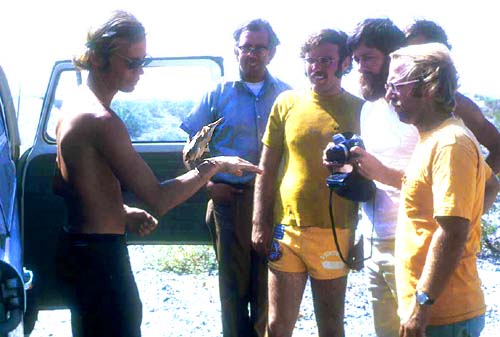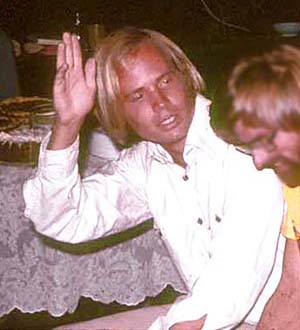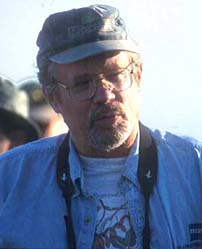 Van
Remsen's time in California was rather short — just the years he went to
college at Stanford and then grad school in ornithology at U.C. Berkeley,
less than a ten year period — but his influence was phenomenal. Van was
an outstanding birder of high energy and endless enthusiasm. He was interested
in most everything having to do with birds, and was eager to share that
knowledge with an entire community of birders. During his years at Berkeley,
he organized weekly visits to the Museum of Vertebrate Zoology, where many
local birders systematically studied the entire collection as they jointly
worked on identification problems. Many of today's best birders, including
several on our "top 40" in this project, credit Van as being one of their
primary mentors in the bird world of the 1970s. Van
Remsen's time in California was rather short — just the years he went to
college at Stanford and then grad school in ornithology at U.C. Berkeley,
less than a ten year period — but his influence was phenomenal. Van was
an outstanding birder of high energy and endless enthusiasm. He was interested
in most everything having to do with birds, and was eager to share that
knowledge with an entire community of birders. During his years at Berkeley,
he organized weekly visits to the Museum of Vertebrate Zoology, where many
local birders systematically studied the entire collection as they jointly
worked on identification problems. Many of today's best birders, including
several on our "top 40" in this project, credit Van as being one of their
primary mentors in the bird world of the 1970s.
Van was already a top birder before he came to California. He grew up near Denver, Colorado, and had associated with the best birders in that state. After two years at Andover, he swore never to go school again in the northeast, and turned down Princeton to go to Stanford where he began to meet California's better observers, such as Dave DeSante. He first appears in the fall 1969 issue of Audubon Field Notes, chasing vagrants (going with Ted Chandik & Mike Parmeter to see a Tropical Kingbird) and gathering data (cited for several specific counts of local shorebirds). In less than 3 years, he was a Regional Editor for northern California (he served for six seasons). He was perhaps most active in Statewide birding during his PhD program at Berkeley, rounding up groups of fellow enthusiasts to drive the length and breadth of California, chasing State birds and searching for vagrants. Van was lively, opinionated, and personable — attributes that (excepting perhaps "opinionated") did not characterize many other California birders. These attributes made Van a leader. In the photo (left or above), Van Remsen
provides a perch for a Least Bittern found lost in Death Valley, as (L
to R) Guy McCaskie, Jon Dunn, John Luther (with camera), Lee Jones (almost
hidden), and Steve Summers look on. We'd stopped at the gas station at
Stovepipe Wells and the attendant, seeing our binoculars, asked if we were
looking for birds. Hearing the affirmative, the attendant told us that
there was a bird from Australia right beyond the station. "Why Australia,"
we asked. "Because its beak is pointing straight up to heaven," he said.
Okay, that made sense. Walking behind the station we found this Least Bittern
doing its best to "freeze" among the desert rocks. It was exhausted and
Van picked it up. We transported the bittern in David Luther's playpen
to Furnace Creek, and released the bird into a reedy pond there. 1 June
1974 © Don Roberson
|
|
 Van's
birding expertise, enthusiasm, and ability to imitate bird calls ("you
should hear his Spotted Owl," wrote Terry Clark in the August 1976 issue
of Western Tanager), made him a natural for several important Big
Day efforts, including an April 1976 run from the Salton Sea to the coast
with Jon Dunn, Kimball Garrett, and Paul Lehman, setting a then-record
206 species in a day in California. Van personally recorded every bird
on the day, and the record would have been 207 but "Van struggles with
his conscience momentarily. By claiming 207, he could set a new individual
record for the most species seen in a single day. But he doesn't feel completely
comfortable about a Hermit Warbler he counted back at Cuyamaca. Deciding
against it, he came down to 206, a record he'll have to share with Paul."
(from the Western Tanager article). This is a good example of the
type of leadership Van attempted to pass on to others: self-discipline,
integrity, and getting your birds right. He was always a critic of sloppy
birding and, instead, promoted the importance of documentation and taking
good daily field notes (e.g., Remsen 1977). Two years later, on 29 Apr
1978, Van was a member of the team (with J.L. Dunn, K.L. Garrett, and R.E.
Webster) that set the still current non-airplane State Big Record record
of 231 species. And Van was the moving force in the ABA's adoption of the
95% rule for Big Day teams (i.e., 95% of all species reported must be confirmed
by all members of the ream) after a thorough analysis of 'good' and 'bad'
prior Big Day efforts. Van's
birding expertise, enthusiasm, and ability to imitate bird calls ("you
should hear his Spotted Owl," wrote Terry Clark in the August 1976 issue
of Western Tanager), made him a natural for several important Big
Day efforts, including an April 1976 run from the Salton Sea to the coast
with Jon Dunn, Kimball Garrett, and Paul Lehman, setting a then-record
206 species in a day in California. Van personally recorded every bird
on the day, and the record would have been 207 but "Van struggles with
his conscience momentarily. By claiming 207, he could set a new individual
record for the most species seen in a single day. But he doesn't feel completely
comfortable about a Hermit Warbler he counted back at Cuyamaca. Deciding
against it, he came down to 206, a record he'll have to share with Paul."
(from the Western Tanager article). This is a good example of the
type of leadership Van attempted to pass on to others: self-discipline,
integrity, and getting your birds right. He was always a critic of sloppy
birding and, instead, promoted the importance of documentation and taking
good daily field notes (e.g., Remsen 1977). Two years later, on 29 Apr
1978, Van was a member of the team (with J.L. Dunn, K.L. Garrett, and R.E.
Webster) that set the still current non-airplane State Big Record record
of 231 species. And Van was the moving force in the ABA's adoption of the
95% rule for Big Day teams (i.e., 95% of all species reported must be confirmed
by all members of the ream) after a thorough analysis of 'good' and 'bad'
prior Big Day efforts.
Despite the seriousness with which he approaches bird identification, Van has a great sense of humor. Some of that humor is displayed in the brilliant little parody on finding the Ringed Turtle-Dove (Remsen & Garrett 1976), published just in time for an ABA convention in southern California. He also published, under the pen name Vanzio Remsenetti, a little piece on how to pronounce "Craveri's" in Craveri's Murrelet (it's Italian, like "spaghetti"). By the mid-1970s, Van had already begun field work on the Amazon River
in Colombia for his doctoral dissertation. There he lived at the research
station on "Monkey Island" and studied five species of kingfishers in nearby
channels (in the photo, right, Van hold up a glass of water straight
out of the Amazon River at Leticia, Colombia). Van set himself up to become
one of the world's leading experts on the Neotropics during that field
work [to simplify slightly, his PhD work showed that big kingfishers eat
big fish and little kingfishers eat little fish; Remsen 1981.]. In the
summer of 1975, Van invited a group of Bay Area birders to join him in
a personally guided tour of Colombia, with everyone just splitting the
costs. Several of our "top 40" California observers took him up on the
offer (e.g., Alan Baldridge, Ted Chandik, John Luther, Don Roberson).
|
|
 When
in California, Van was very much a part of the social scene (photo right
from a birding party in July 1976; more on that party on the
Jon
Dunn page). When
in California, Van was very much a part of the social scene (photo right
from a birding party in July 1976; more on that party on the
Jon
Dunn page).
Among Van's significant contributions to California ornithology were his two-part article (with L.C. Binford) on the status and identification of Yellow-billed Loon (Binford & Remsen 1974, Remsen & Binford 1975), his surveys of remote mountain ranges in the Mojave Desert (with Steve Cardiff), and his preparation of the first government-sponsored "Bird Species of Special Concern" (Remsen 1978). After leaving California in the late '70s, Van began a career as a professional ornithologist at Louisiana State University, Baton Rouge. LSU already had a strong neotropical emphasis, and Van's participation would lead it to new heights. Today he is the Curator of Birds at LSU, as well as a member of the A.O.U. Checklist Committee, and chair of the South American Checklist Committee. He has published extensively on the ecology, distribution, and taxonomy of South American birds, and other topics of interest (e.g., his paper on the importance to bird conservation of collecting birds is recommended to all birders; Remsen 1995). Van was also among the scientific advisors on the search for the Ivory-billed Woodpecker, and co-author of the paper on the species' rediscovery Finally, if you want to be jealous about something, try this: Van has a bird named after him — Chestnut-bellied Cotinga Doliornis remseni. It is known only from the páramo of the central Andes of Colombia and the eastern Andes of Ecuador [Robbins, M.B., Rosenberg, G.H., and Sornoza, F. 1994. A new species of cotinga (Cotingidae: Doliornis) from the Ecuadorian Andes, with comments on plumage sequences in Doliornis and Ampelion. Auk 111: 1-7.] |
|
Official Bird Name: Golden Tanager
Selected publications on California topics 1974-1989:
 Short
selection of other publications (there are many, many more): Short
selection of other publications (there are many, many more):
|